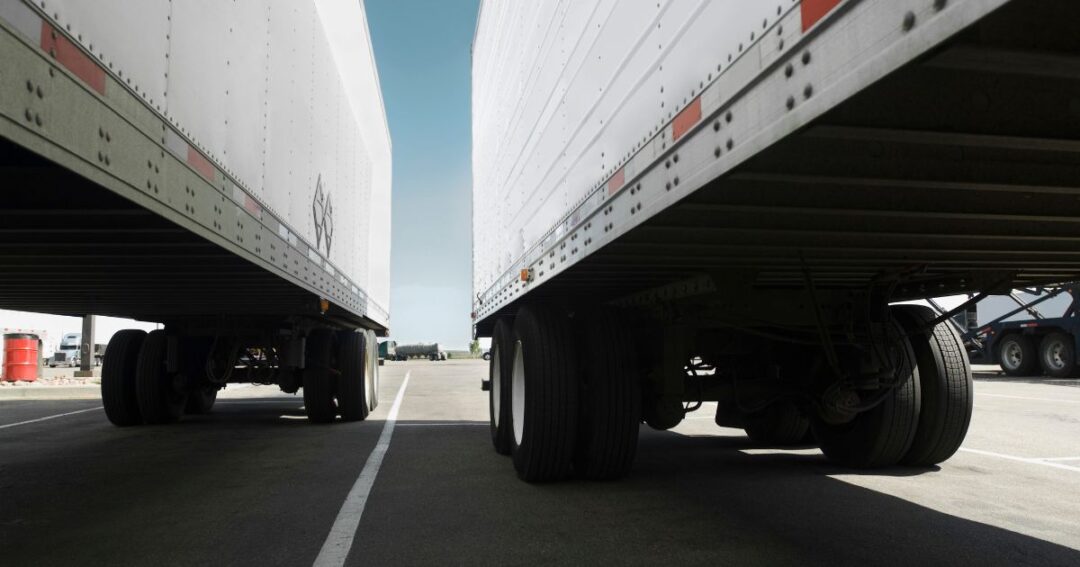The freight transportation industry is like your local market: sometimes there’s a flood of goods, sometimes shelves are bare. This constant push and pull between demand (freight volumes) and supply (truck capacity) directly impacts your bottom line.
Whether you’re a shipper facing capacity challenges or a carrier seeking to optimize your fleet, the ‘battle’ of supply and demand is about mastering costs and schedules to keep your supply chain running smoothly.
At Chief Carriers, we specialize in navigating the intricate relationship between freight volumes, truck capacity, and the broader freight market, especially within the flatbed sector. We’ll provide insights into volume impacts, identify key market trends, and offer strategies to navigate fluctuations, ultimately reducing logistical stress for both sides of the industry.

The Core Relationship Between Freight Volumes and Truck Capacity
The relationship between freight volume and truck capacity is a classic case of supply and demand. Freight volume represents the demand—how many goods need to be shipped. Truck capacity represents the supply—how many trucks and drivers are available.
When freight volumes are high and truck capacity is low, a tight market emerges and the following conditions occur in the freight industry:
- Increased Freight Rates: Shippers compete for available trucks, driving up freight rates.
- Potential Shipping Delays: Finding available trucks becomes challenging, leading to freight shipment delays.
- Increased Pressure on Logistics Operations: Logistics teams face heightened pressure to secure capacity and manage schedules.
Conversely, when freight volumes are low and truck capacity is high, a loose market prevails and causes the following freight industry changes:
- Decreased Freight Rates: Carriers compete for loads, resulting in lower freight rates.
- Increased Truck Availability: Scheduling shipments becomes easier due to ample truck availability.
This dynamic interplay directly impacts the profitability of shippers and carriers, making it vital to understand the factors that influence it.

Factors Influencing the Correlation
The ever-shifting balance between freight volume and truck capacity is a complex interaction of numerous dynamic factors, with changes in one creating ripple effects in the others.
Economic Indicators
A strong economy typically boosts freight volumes, while a downturn reduces them. Gross Domestic Product (GDP) growth, manufacturing output, consumer spending, housing starts, and unemployment rates provide valuable insights into the current economic conditions. Shippers and carriers closely monitor these indicators to anticipate changes in the freight industry and adjust their strategies accordingly.
Seasonal Fluctuations
Industries like retail and agriculture experience seasonal peaks in shipping demand. The retail industry experiences holiday shopping, back-to-school shopping, and promotional shopping peaks. The agricultural industry peaks occur during crop harvests, planting, and harvest goods transportation. These seasonal fluctuations can create temporary imbalances between freight volume and specialized truck capacity for shipping items like perishable goods or farm equipment.
Fuel Prices
Rising fuel costs significantly reduce truck capacity by squeezing profit margins, particularly for smaller carriers. They’re forced to limit trips, prioritize shorter routes, and be more selective with loads. High fuel prices increase carrier operating costs, leading to lower profitability and fewer available trucks on the road.
Carriers apply fuel surcharges and adjust base freight rates, directly passing the increased operational costs to shippers. The reduction in truck capacity caused by high fuel prices, combined with consistent or growing demand, drives freight rates upward due to basic supply and demand principles.

Driver Shortages
A lack of qualified drivers directly reduces truck capacity. Available trucks idle without operators, which is exacerbated by an aging workforce and difficulties attracting recruits. The challenge is compounded by retention issues and a significant impact on long-haul capacity, leading to potential supply chain disruptions.
The driver shortage makes moving high freight volumes extremely challenging through increased freight rates and additional pressure on logistics operations.
Specific Freight Types
The flatbed sector often faces unique capacity challenges due to the equipment and securement requirements for hauling items like steel, lumber, and construction materials. Refrigerated goods transportation demands specialized trailers and temperature control, which can create truck capacity constraints. Transporting oversized loads or hazardous materials requires specialized permits, routing, and handling procedures, which impacts the availability of carriers and equipment.
Global Supply Chain
Events on the international stage, such as geopolitical tensions, trade agreements, and economic fluctuations in other countries, can create ripple effects that directly impact freight movement within the U.S. Disruptions at major ports due to congestion, labor disputes, or natural disasters can create bottlenecks in the supply chain, causing imbalances between freight demand and truck capacity.

Warehousing and Distribution
Inventory levels in warehouses directly influence the demand for transportation, requiring more inbound and outbound freight movement. Bottlenecks or limitations in warehousing can create delays and impact the flow of goods, affecting the demand for trucks. Distribution strategies, such as the use of regional distribution centers or e-commerce fulfillment centers, can significantly alter freight patterns and the types of truck capacity required.
Driver Regulations
Hours-of-service regulations are designed to prevent driver fatigue. These regulations directly limit the time drivers can spend behind the wheel, reducing overall driver availability and impacting truck capacity. These rules, while essential for safety, reduce productivity and create capacity constraints, especially during periods of high freight demand.
Other Regulations and Policies
Environmental regulations, such as emissions standards for trucks, can influence the availability of newer, compliant vehicles and increase operating costs for carriers. Infrastructure spending on roads, bridges, and ports impacts the efficiency of freight movement. Policies related to trade, taxation, and labor laws can also have ripple effects on freight volumes and the trucking industry’s ability to meet demand.
Actionable Strategies for Shippers
Shippers can implement several strategies to navigate the complexities of fluctuating freight volumes and truck capacity.
- Optimize Shipping Schedules and Routes: Efficient route planning and flexible schedules can minimize delays and reduce costs.
- Proactive Planning and Forecasting: Stay informed about economic indicators and seasonal trends to anticipate changes in freight volumes.
- Peak Season Strategies: Secure capacity in advance and diversify transportation options to manage increased demand during peak seasons.
- Cost Management: Negotiate contracts, explore alternative shipping methods, and leverage technology to control transportation costs.
- Leverage Technology: Utilize transportation management systems (TMS) to improve visibility, optimize routes, and streamline operations.
- Planning for Future Changes: Staying up to date on market analysis and news in the freight market is essential when planning for future changes in the freight industry.

The Expertise and Technology Advantage of Chief Carriers
At Chief Carriers, we leverage our flatbed trucking specialization, deep understanding of the market, and streamlined internal operations to anticipate and adapt to changing conditions, ensuring efficient capacity management and timely delivery. Utilizing cutting-edge technology, we optimize routes, track shipments, and provide real-time updates for transparency to our customers.
We assist clients in navigating the fluctuating freight market conditions by providing current and relevant information, acting as a valuable resource in the dynamic transportation landscape.
Optimizing Truck Capacity and Freight Volumes in Today’s Market
The relationship between freight volumes, truck capacity, and supply and demand is a cornerstone of the freight transportation industry. By understanding these dynamics and implementing effective strategies, shippers can mitigate risks and optimize their operations. Partnering with a knowledgeable and reliable provider is key for successfully navigating these challenges.
Contact Chief Carriers today to learn how we can help you optimize your shipping operations and build long-term success. We are ready to help you manage your freight volumes and any other shipping needs.

